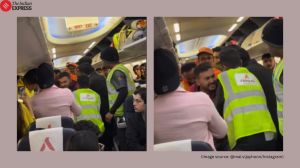Cartoons as Backdrops
There are certain coincidences which one would like to forget. The day the well-known young cartoonist, Irfan Hussain disappeared, we wer...

There are certain coincidences which one would like to forget. The day the well-known young cartoonist, Irfan Hussain disappeared, we were performing our new play on religious intolerance, on the occasion of the International Women’s Day, with three of Irfan’s cartoons as backdrops. A few days later, in the midst of the same play, with his cartoons as backdrops, we were informed of his brutal murder.
The last five years have been a golden period of political cartooning in India. A renowned cartoonist recently commented, "Till few years back, we had very few politicians who could be the subject of caricatures. Now we have the whole lot of them, each of whom can be caricatured". The resultant spurt in cartooning, greatly enriched our street theatre performances, which have not only minimal costumes and properties, but also, for a long time, have had almost no backdrops. We began using blown-up cartoons from newspapers and weeklies as backdrops during the Hawala days.
This novel experiment not only gave more substance to the theme, but also made the presentation visually more attractive. The cartoons of Sudhir Dar, Unni, Sudhir Telang, Laxman, Rajendar, and Irfan in the background were a great help in making our plays and songs on Hawala more communicative and deft. Cartoons became an integral constituent of our performances. Adding to its artistic outlook, cartoons helped us in countering the critics of street theatre that it was devoid of artistic substance.
But Irfan’s cartoons, appearing regularly in a weekly, even provided us with a new set of ideas for our future productions. His cartoons, were in fact, independent scenes which could be developed into full-fledged street plays. They also helped us immensely in developing tableaux that had greater mobility than plays. One of his cartoons on the fate of Indian secularism, carrying a cross on which rode a ferocious-looking character named as VHP, was instantly turned into a tableau and became extremely popular with the audiences.
What was so special about Irfan’s cartoons that they could be turned into live scenes? In the words of Rajendar Puri, a senior media personality, "Irfan had enormous talent. He was not only a good caricaturist and draftsman. He was a good idea man too… He was also a trained animator. That made him one of the hottest prospects among the youngest political cartoonists".
By January 1999, we had an entire series of Irfan’s cartoons lampooning and caricaturing the forces of religious intolerance in our country. It became a part of our new play on religious intolerance – Zindagi Gati Rahegi (Life Will Go On Singing). The same month, I rang up Irfan at his office to inform him about this new venture of ours. He spoke very gently, in a low-pitched, but confident voice, but which had no trace of self-importance. He was pleased with the information and suggested few more cartoons done by other cartoonists on the theme. He wished us luck and expressed that he wanted us to be more active.
This was the first, and most unfortunately the last time we interacted. We have since travelled with his cartoons to different parts of Delhi, Haryana, Uttar Pradesh, and Gujarat. From March 12 onward, we have added his portrait (done by a member of our group) in our processions, along with his work.There are people who want to wish away Irfan’s horrendous killing as part of a general spree of criminalisation in and around Delhi. However, there are strong pointers that Irfan was murdered for his creativity in exposing the forces of religious intolerance. Robbers or car-jackers do not inflict 28 fatal wounds, and that too, after slitting the throat of the victim with a sharp-edged weapon. Such brutality occurs only during communal or caste violence.
Irfan used to present every retiring colleague in the daily he worked, his cartoon as a parting gift in the farewell parties. Once, at a similar party, he commented lightly "I have been making cartoons for each one of them, but no one will draw for me the day I leave".
Dear Irfan, I wish you could hear all those who loved you, appreciated you! We will not let you ever pass or retire. We will carry your commitment, your creativity, your zeal, and your love for this country, to its every nook and corner. We will take your artistic heritage to the common people of this country, who love this country as you did.





- 01
- 02
- 03
- 04
- 05


























